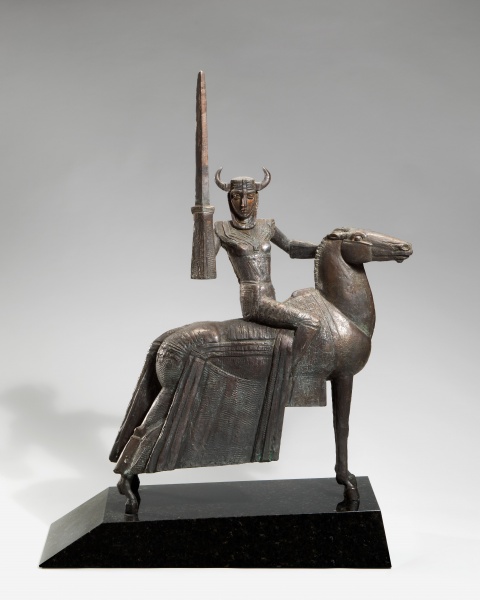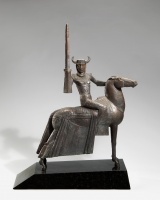
Gražina
| Author: |
Daliutė Ona Matulaitė (1942–2025) |
| Created: | 1973–1985 |
| Material: | bronze |
| Dimensions: | 63 × 40 cm |
The first exhibition version of the monument to Gražina was created in 1973, a year after the death of Romas Kalanta. According to Daliutė Ona Matulaitė (1942-2025), she was working at an art school at the time, and passed by the monument to Chernyakhovsky every day. She found the relief of the monument, depicting Lithuanian women giving flowers to the conquerors, very annoying. Inspired by Adam Mickiewicz’s poem, she sought to create the antithesis: a woman as a symbol of resistance, a female warrior. Gražina is represented on a horse and brandishing a sword, at the moment she leads the army against the Germans, disguised in the clothes of Liutauras.* In 1974, after seeing the bronze sculpture in an exhibition, the chairman of the executive committee of the city of Birštonas ordered a large sculpture of Gražina over four metres high to be erected beside the River Nemunas. However, the project was never realised. Later, in the early years of regained independence, two bronze versions of this sculpture were cast in Tallinn. One was put up in Alytus, and the other in the courtyard of the Seimas of the Republic of Lithuania. Although the female warrior is depicted at a dramatic moment, the sculptor aimed to keep the sculpture static, illustrating the unity of horse and woman, her calmness, and her ability to control the soldiers. Thus, it captures a moment of concentration before a decisive battle.
Text author Jurgita Ludavičienė
* She dared not wake her husband from his sleep, / Perhaps unwilling to beg in vain. / Silently, she stood without calling his name / And suddenly drew her husband’s sharp sword. / Donning his clothes over Liutauras’ armour, / She closed the door and hurried to the porch.
Source: Law firm Valiunas Ellex art album THE ART OF MATERIALS. Compiler and text author Jurgita Ludavičienė© LATGA, Vilnius 2025







